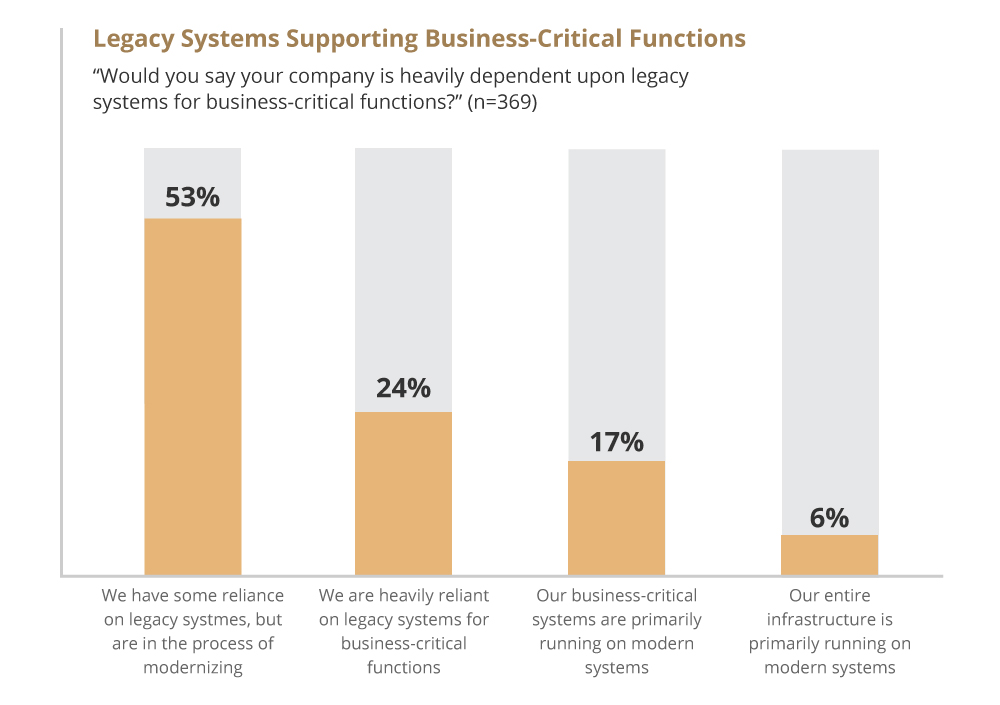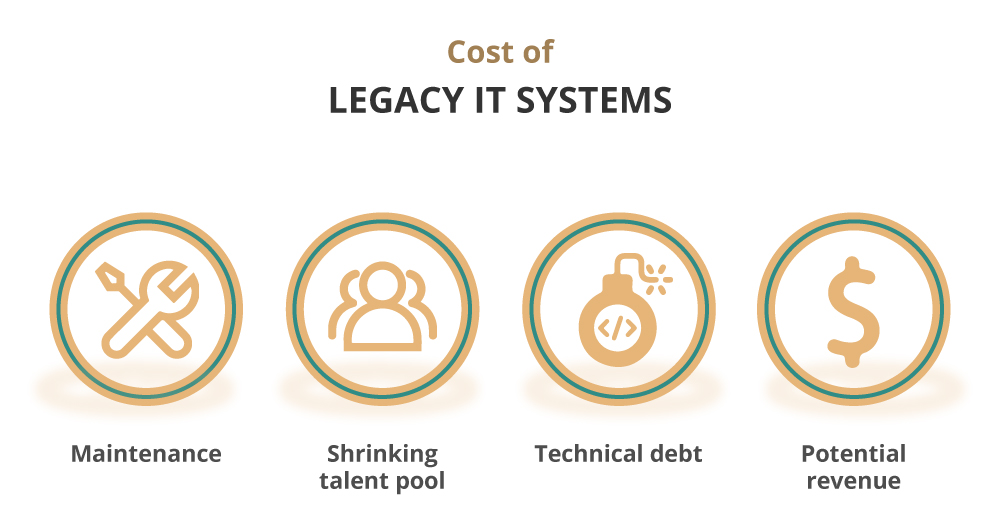< Back to insights
Published 21. Jun. 2022
Legacy IT System Modernization: Benefits & Barriers
A key challenge facing IT leaders in the fast-changing digital landscape is the constraints of legacy systems which limit business agility. These old systems are becoming increasingly difficult to change and no longer provide efficient support to growing business activities.
However, the continuing process of transforming legacy IT systems is no easy task. As of 2020, 78% of companies are still reliant on outdated business critical systems, though many have started modernization efforts. About 33% are depending on legacy technology for overall systems.
The Benefits of Legacy Modernization
Legacy modernization isn’t just about updating IT systems with the latest technological tools. Instead, it is a critical component that has helped accelerate digital transformation efforts by reducing network complexity and cost, enabling cross-platform collaboration, and optimizing process flexibility.
Cost Reduction
The main benefit of modernization is cost reduction. Cleo reports that organizations lose about USD $1 million in total annual revenue due to legacy technology and applications. The lack of interoperability inherent in legacy systems hinders digital transformation and incurs additional costs to businesses when new technology is introduced into a non-homogenous IT architecture, creating lost opportunities.
Beyond that, legacy systems are also expensive to maintain the older they get, costing businesses up to 15% each year for just maintenance. OverOps estimates that poor quality in legacy systems cost businesses in the US about $520 in 2020. Similarly, the shrinking pool of skills and knowledge required to operate and service legacy systems will end up costing companies more in the long run as these skills become more expensive.
Another major cost of legacy systems is technical debt – the cost incurred by reworking legacy systems due to the implementation of limited short-term solutions over effective strategies that do better in the long run.
Overhauling legacy systems can be a complex and costly decision. However, the longer decision makers wait to implement transformative solutions, the higher the technical debt. This debt also includes the potential revenue a business loses due to the inability to stay competitive in a fast-changing market.
Modernizing IT systems will significantly reduce these costs, saving organizations millions each year that could otherwise be channeled into other valuable endeavors.
Better Mitigation of Security Risks
Generally, legacy systems are more vulnerable to cybersecurity threats. Over time, the security capabilities of legacy IT systems become outdated. The network may no longer have the necessary technology to deter modern attacks, making them an easy target for bad actors.
This poses a significant business risk and additional cost for businesses. IBM’s Cost of Data Breach Report estimates that the average cost of a data breach in 2021 is $4.25 million, the highest it has been since 2015.
Check Point Software found that state and local governments in the US experience a 102% increase in cyberattacks on critical infrastructure in the first half of 2021. Many of these were running on legacy systems.
Moreover, the volatile global conflicts – such as the Russia-Ukraine war – also has a ripple effect on cybersecurity, with US-based cybersecurity agencies observing an 800% increase in cyberattacks in the the two days following the start of the Russia-Ukraine war.
This makes the case for legacy modernization, which would enable organizations to shore up against more sophisticated cyber threats.
Increased Competitive Advantage
Another clear benefit of updating legacy systems is that a more integrated network makes businesses more agile and scalable. These are both important traits for any organization that wants to stay competitive.
An agile and flexible business is better able to react and change to the environment and market demands. It is also better able to serve its employees by optimizing processes to increase productivity while also serving customers more efficiently.
Modernized systems also free up valuable IT resources that would otherwise be occupied with putting out fires within the legacy system that is no longer supported by third-party vendors.
Without the need to constantly babysit legacy systems, IT teams can focus on tasks that will drive the business forward such as exploring advanced technology and innovative transformation ideas to serve shifting demands.
Barriers to Modernization
Though the IT leaders are focused on legacy modernization, Cleo found that the 2021 Advanced Mainframe Report notes that 74% of organizations fail to complete these projects. The report suggested that part of the reason for this is that organizations have underestimated the complexity of the processes involved, especially as they were rushed into it due to the pandemic.
Breaking it down further, Levvel’s Legacy Modernization Report states the lack of buy-in from key decision makers in an organization is major factor, with 45% of leaders saying that a main barrier to modernization is it is a low priority compared to other initiatives.
Another 37% said that it is because the business and IT sides of the organization are not aligned while 31% feel that there is no clear return of investment (ROI) to legacy modernization.
Our Executive Trend Survey supports these findings, with 53.4% of IT leaders noting that the biggest internal challenge they face with tech adoption is integration with legacy systems. The incompatibility of aging IT systems creates a mounting technical debt that would only make legacy modernization even tougher task than it already is.
In line with that, modernization efforts require careful planning to ensure that legacy IT systems are modernized in the most efficient ways possible, using the best tools and without compromising key business functions. In fact, 38% of IT leaders blamed the failure of their organization’s legacy modernization projects on a lack of planning.
Managing Legacy Modernization
Replacing or upgrading an entire IT system is a complicated process, especially when business critical systems are involved. However, there are certain strategies IT leaders are keeping in mind when tackling this mammoth task.
Approaching legacy systems modernization with a holistic mindset is key and requires buy-in from decision makers as well as team members. After all, Levvel notes that the primary resistors to modernization are business-critical leaders (26%), executives (24%), and IT teams (20%).
One way to encourage buy-in is by setting a clear plan and defined ROI based on frank discussion with all levels of the organization about where transformation is most needed and how it can serve them.
Each organization will have to carefully study its current IT systems to decide across all levels where modernization will have the best impact on revenue, market share, customer experience, security, productivity and other business metrics.
It is up to IT leaders to lead the way for legacy modernization that is cost-effective and as streamlined as possible. How would you do it?
Sign up now: Become a member of Aurora Live Executive Business Network, to enjoy free access to the IT Insights webinar series, exclusive networking opportunities, and more.



